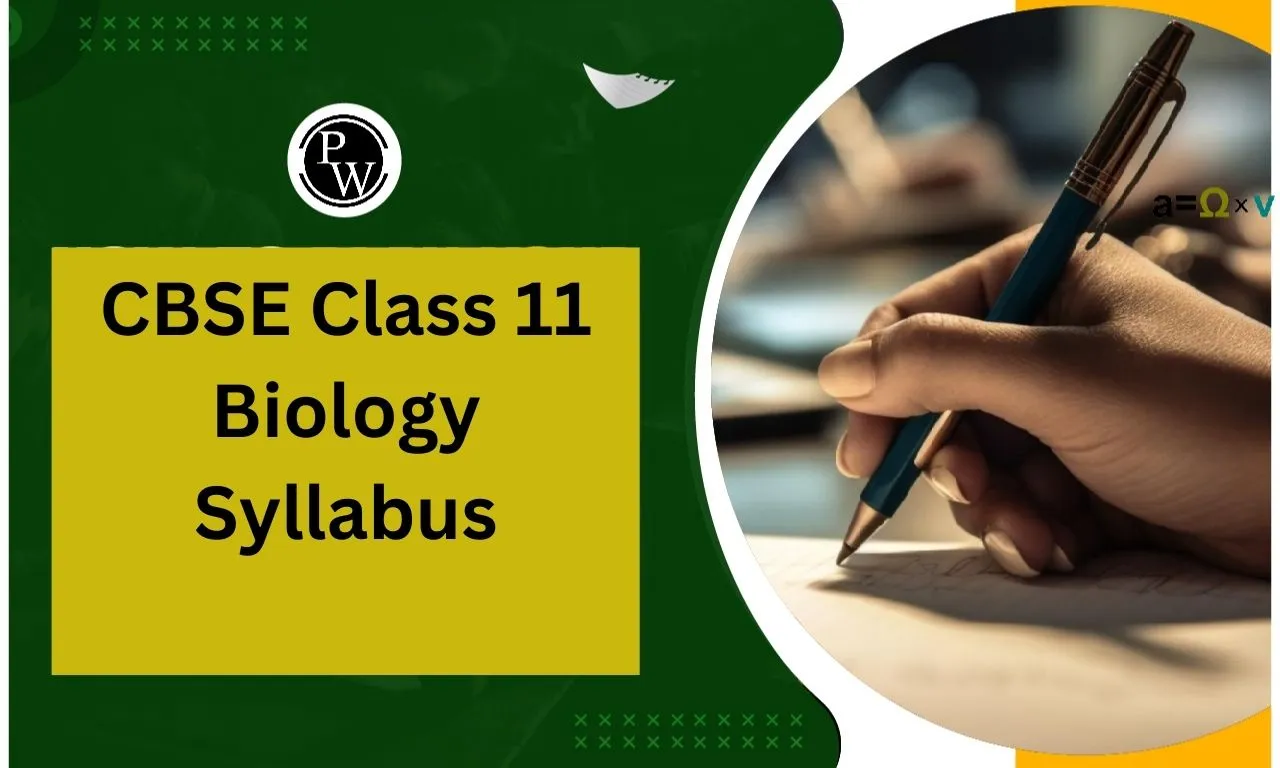
CBSE Class 11 Biology Notes Chapter 2: On this page, we have made the CBSE Class 11 Biology Notes Chapter 2 available in PDF format. All of the unit's key points are contained in the PDF.
Before tests, students can review the information here quickly in addition to the textbook. Students can be sure that our CBSE Class 11 Biology Notes Chapter 2 will allow them to review it at any time, or any place. The rationale is that the link provided below allows you to download this PDF.
CBSE Biology Notes for Class 11 Chapter 2
Class 11 biological classification is the process of dividing up organisms according to their characteristics.
This chapter requires understanding and memorization skills because it requires you to retain several crucial phrases and details. To find out about all the significant subjects discussed in the chapters, read the article below.
CBSE Class 11 Biology Notes Chapter 2 PDF
While reading the textbook is crucial, consulting the CBSE Class 11 Biology Notes Chapter 2 is also helpful. This can be used as a last-minute study tool before tests. Thus, download the CBSE Class 11 Biology Notes Chapter 2 from us, which are checked by subject matter specialists.
CBSE Class 11 Biology Notes Chapter 2 PDF
CBSE Class 11 Biology Notes Chapter 2
The practice of classifying organisms based on shared characteristics is known as biological categorization.
The two kingdoms of classification were proposed by Linnaeus, who categorised species into the Animalia kingdom (animals) and the Plantae kingdom (plants).
Due to its inability to discriminate between eukaryotes and prokaryotes, unicellular and multicellular creatures, and photosynthetic and non-photosynthetic species, the classification of two kingdoms has certain limitations.
Five Kingdoms Classification
It was RH Whittaker who proposed the five-kingdom system. These five kingdoms are categorised as follows: Animalia, Plantae, Fungi, Protista, and Monera. The thallus's organisation, cell structure, feeding strategy, evolutionary relationship, and mode of reproduction were the basis for the classification.
Kingdom Monera
One of the primary components of Monera is the bacterium. This kingdom contains both bacteria and blue-green algae, all of which are prokaryotes. They can be found in extremely harsh environments like deep oceans, snow, deserts, and hot springs. As prokaryotes without a distinct nucleus, all monerans are. They can be parasites as well as autotrophs and heterotrophs. There is a cell wall.
Archaebacteria
There are three types of archaebacteria: methanogenic (live in marshy places), halophilic (survive in high salt concentrations), and thermoacidophilic (live in hot springs). Compared to other monerans, their cell wall structure is different. Methanogens aid in the production of biogas from animal excrement and are present in the intestines of several ruminants, including cows and buffalo.
Eubacteria
We refer to them as "true bacteria". They are distinguished by having a stiff cell wall and a movable flagellum. contains blue-green algae, or cyanobacteria. Since they have chlorophyll a, they resemble plants. They are referred to as photosynthetic autotrophs for this reason. Cyanobacteria are filamentous, unicellular algae that grow into colonies encased in a gelatinous sheath. Some have unique features called heterocysts, which aid in the fixation of nitrogen in the environment. Take Nostoc, for instance.
Chemosynthetic Autotrophs
Certain inorganic compounds, such as nitrites and nitrates, can be oxidised by these bacteria. ATP is created using the energy that is liberated during the oxidation process. Asexual reproduction in bacteria is possible through a mechanism known as binary fission. If conditions are unfavourable, they can also proliferate through spores. Mycoplasma is included in the Monera category as well. Since they lack a cell wall, they can thrive in anaerobic environments. The smallest known living organism is Mycoplasmas.
Kingdom Protista
Eukaryotes with a single cell that belongs to the kingdom Protista. Most of them have an aquatic habitat. It is discovered that they are eukaryotic, unicellular creatures. Their nucleus is identifiable and encircled by the nuclear membrane. They can move via both flagella and cilia, breathe both aerobically and anaerobically, and reproduce both sexually and asexually. They are separated into protozoans, euglenoids, dinoflagellates, slime moulds, and chrysophytes.
Chrysophytes
It is made up of golden algae and diatoms. Both freshwater and saltwater are home to them. Most of them are photosynthetic. Their unbreakable cell wall is a result of the silica present in it, which also contributes to the development of diatomaceous earth. They are the primary oceanic producers. Most of them are flagellates with a single cell. They resemble amoeboids.
Dinoflagellates
These organisms are marine and carry out photosynthesis. They may have a variety of colours, such as blue, red, brown, or yellow. The presence of various coloured pigments within the dinoflagellate cells is what gives the illusion of colour. Cellulose makes up the cell wall. They have two flagella; one is positioned transversely, and the other longitudinally. Among the instances are Noctiluca scintillans and Gonyaulax catenella.
Euglenoids
Freshwater organisms known as euglenoids are found in stagnant water. A layer known as a pellicle, which is rich in proteins, surrounds these organisms. They can function as both autotrophic and heterotrophic organisms, such as Euglena, and have one long and one short flagellum. Chloroplasts are present in the majority of euglenoids so they can produce their sustenance. The paramylon (carbohydrate) food stores are present in euglenoids.
Slime moulds
They are saprophytic by nature, and in the right circumstances, they can produce plasmodiums, which are aggregation. They have real cell walls, are quite resistant to harsh environments, and under poor circumstances, develop fruiting bodies with spores.
Protozoan like Protists
It is known that they are heterotrophs. They can exist as parasites and predators. Four categories of protozoa exist: Freshwater, moist soil, and saltwater are home to amoeboid protozoa, which have pseudopodia that allow them to consume food particles like those found in amoeba. Flagellate protozoa can be classified as either parasitic or free-living. Numerous parasitic illnesses are caused by this group of organisms. Trypanosoma, for instance, is the cause of sleeping sickness. Thousands of cilia are present in ciliated protozoa. They can travel forward or backwards thanks to the cilia's movement. It also facilitates the intake of external food. Consider Paramecium.
Kingdom Fungi
Since fungi are naturally heterotrophic, some of them can feed on live things, referred to as parasites, while others are saprophytes, meaning they feed on dead organic matter. Lichens are fungi that have the ability to coexist with other living things, including algae. We refer to these fungi as symbionts. Mycorrhiza is the symbiotic link between fungi and the roots of higher plants, whereas lichens are the symbiotic relationship between fungi and algae. Fungi can reproduce in a variety of ways, including fission, fragmentation, and budding.
Conidia, zoospores, or sporangiospores are terms for spores that are used in asexual reproduction. Different spores called oospores, ascospores, and basidiospores are used in sexual reproduction. Phycomycetes, or lower fungi, reproduce asexually by producing motile spores called zoospores and immobile spores called aplanospores. The sporangium is where the spores are made.
The gametes fuse to create the zygospore. The mycelium is multicellular and coenocytic (has several nuclei). For instance, Rhizopus, Albugo, and Mucor. Ascomycetes, or SAC fungi, can live as parasites or saprophytes. Through conidia, asexual reproduction can place. Ascospores are the means of sexual reproduction; Ascomycetes, such as Penicillium, Aspergillus, Claviceps, etc., have septate and branching mycelium. Basidiomycetes (Club Fungi): The mechanism of fragmentation is used in vegetative reproduction.
There are no sexual organs. The basidium is formed by plasmogamy between two vegetative or somatic cells. To create four types of basidiospores, such as Agaricus (mushrooms), Ustilago (fire rot), etc., the basidium goes through karyogamy and meiosis. Because deuteromycetes do not reproduce sexually at any point during their life cycle, they are sometimes referred to as defective fungi. Through conidia, sexual reproduction takes place. Some examples of septate and branching mycelium are Alternaria, Trichoderma, and so on. A fundamental class of fungus are called zygomycetes, or conjugation fungi. Sporangiospores, which are non-motile, reproduce asexually. Consider Rhizopus.
Kingdom Plantae
- It encompasses all multicellular, photosynthetic, eukaryotic plants.
- The following traits apply to members of the Plantae family:
- Their nature is eukaryotic for the most part.
- Its primary pigment is chlorophyll.
- Cellulose makes up its cell wall.
- Food synthesis is aided by photosynthesis.
- Reproduction can occur through sexual or asexual means.
- They stand for the phenomenon of haploid gametophytes and diploid sporophytes, which alternate between generations.
Kingdom Animalia
These creatures belong to the eukaryotic and heterotrophic categories. The following are a few traits shared by Animalia members:
- They are different-sized multicellular creatures.
- The skeletal system, circulatory system, respiratory system, and other organ systems are all fully developed.
- It is discovered that they have bilateral symmetry.
- They have well-developed locomotor organs as well.
- Breathing occurs through the skin, lungs, book gills, gills, etc.
- membrane-bound cell organelles and a nuclear membrane are enclosing the nucleus.
- The heart, blood arteries, and blood itself are the three main conduits for circulation.
- Haploid gametes are formed during the process of reproduction. A diploid zygote created by the union of the gametes splits to create a new diploid creature.
- The most significant excretory organ is the kidney.
Viruses
Since viruses are acellular structures, they are not included in Whittaker's taxonomy of the five kingdoms. They are made up of a protein coat that envelops nucleic acid, which can either be DNA or RNA. These viruses are limited to growing and replicating inside the host cells. Viruses reside outside of their host cells as crystals. They seriously harm the host and spread disease. For instance, the human immunodeficiency virus (HIV) causes AIDS, variola causes smallpox, etc.
Viroids
They are made entirely of nucleic acid without a protein shell, making them the tiniest known infectious structures.
Lichens
They are recognised as the symbiotic relationships between fungus and algae. The algal constituents produce food through photosynthesis and are autotrophic. The fungal component provides cover and safety.
Benefits of Biology Notes for Class 11 Chapter 2
- These review materials will help students understand the topics covered in the chapter on biological classification.
- Students will be able to confidently answer all exam questions based on this material by consulting these notes.
- The subjects are explained by the specialists in a clear, concise manner.
- The notes include bullet points and are organised neatly.
- These notes are crafted by subject matter experts after a thorough examination of the subjects addressed.
- These error-free revision notes were created with the understanding that students need to review chapters more quickly and effectively, without skipping over any important topics.
- With its help, students can finish their topic preparation in less time—even the night before the exam.
CBSE Class 11 Biology Notes Chapter 2 FAQs
What is the toughest chapter in biology class 11?
Is 11th biology tough?
What are the key points of biological classification?










